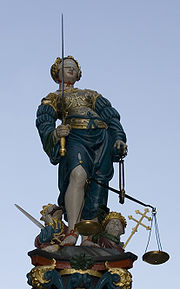
Hans Gieng
Encyclopedia


Renaissance
The Renaissance was a cultural movement that spanned roughly the 14th to the 17th century, beginning in Italy in the Late Middle Ages and later spreading to the rest of Europe. The term is also used more loosely to refer to the historical era, but since the changes of the Renaissance were not...
sculptor best known for his public fountain
Fountain
A fountain is a piece of architecture which pours water into a basin or jets it into the air either to supply drinking water or for decorative or dramatic effect....
figures in the Old Town
Old City of Berne
The Old City of Bern is the medieval city center of Bern, Switzerland. Built on a narrow hill surrounded on three sides by the Aare River, its compact layout has remained essentially unchanged since its construction during the 12th to the 15th century...
of Bern as well as Fribourg
Fribourg
Fribourg is the capital of the Swiss canton of Fribourg and the district of Sarine. It is located on both sides of the river Saane/Sarine, on the Swiss plateau, and is an important economic, administrative and educational center on the cultural border between German and French Switzerland...
.
Biography
Gieng, who was probably of SwabiaSwabia
Swabia is a cultural, historic and linguistic region in southwestern Germany.-Geography:Like many cultural regions of Europe, Swabia's borders are not clearly defined...
n origin, is recorded to have become a citizen of Fribourg and a member of the traders' guild in 1527. He likely first worked in the sculpture workshop of Hans Geiler, whom he succeeded in 1533. In earlier centuries, Geiler and Gieng were sometimes confused with one another, but modern research indicates that they were actually two distinct persons.
As a sculptor, Gieng was mainly active in Fribourg. He also worked in Bern in the 1540s, in Solothurn
Solothurn
The city of Solothurn is the capital of the Canton of Solothurn in Switzerland. The city also comprises the only municipality of the district of the same name.-Pre-roman settlement:...
from 1554–56, and in 1557 in St. Gallen
St. Gallen
St. Gallen is the capital of the canton of St. Gallen in Switzerland. It evolved from the hermitage of Saint Gall, founded in the 7th century. Today, it is a large urban agglomeration and represents the center of eastern Switzerland. The town mainly relies on the service sector for its economic...
.
Works
Gieng's style is close to Swabian art: traditional and still in the style of Gothic artGothic art
Gothic art was a Medieval art movement that developed in France out of Romanesque art in the mid-12th century, led by the concurrent development of Gothic architecture. It spread to all of Western Europe, but took over art more completely north of the Alps, never quite effacing more classical...
in his religious creations, but forceful and realistic in the secular works.
Freiburg
In Freiburg, the Renaissance council table (1546) and the figures of the seven public fountainFountain
A fountain is a piece of architecture which pours water into a basin or jets it into the air either to supply drinking water or for decorative or dramatic effect....
s (1547–60), considered the most significant ensemble of sculptural art from this period in Switzerland, are among his principal works.
Bern
Gieng created several if not most of the public fountains of Bern that were put up between 1542 and 1546. His presence in the city is sparsely attested in the surviving record: a 1543 Council diary entry reports a “Meyster Hans, Bildhower, im grossen Spital z'Herbrig sin und an des spittelmeisters tisch ässen” (“Master Hans, sculptor, residing in the great HospitalHospital
A hospital is a health care institution providing patient treatment by specialized staff and equipment. Hospitals often, but not always, provide for inpatient care or longer-term patient stays....
and eating at the Spitalmaster's table”).
For this reason, his authorship of the individual fountain figures, which are unsigned, has long been a matter of dispute. Paul Schenk's seminal work of 1945, Berner Brunnen-Chronik (Bernese Fountain Chronicle) attributes three fountains to Gieng with certainty—the Pfeiferbrunnen (piper
Bagpipes
Bagpipes are a class of musical instrument, aerophones, using enclosed reeds fed from a constant reservoir of air in the form of a bag. Though the Scottish Great Highland Bagpipe and Irish uilleann pipes have the greatest international visibility, bagpipes of many different types come from...
fountain), the Kindlifresserbrunnen (ogre
Ogre
An ogre is a large, cruel, monstrous, and hideous humanoid monster, featured in mythology, folklore, and fiction. Ogres are often depicted in fairy tales and folklore as feeding on human beings, and have appeared in many classic works of literature...
fountain) and the Simsonbrunnen (Samson
Samson
Samson, Shimshon ; Shamshoun or Sampson is the third to last of the Judges of the ancient Israelites mentioned in the Tanakh ....
fountain)—while considering it "quite possible" that Gieng also created the other wells. Later works such as Paul Hofer
Paul Hofer
Paul Hofer is a former professional American football player who played running back for six seasons in the NFL. He was a part of the San Francisco 49ers Super Bowl XVI winning team. Known for his hard and relentless running style, Hofer was a fan favorite despite being on poor 49ers teams in the...
's Kunstdenkmäler des Kantons Bern of 1952 or Berchtold Weber's Historisch-topographisches Lexikon der Stadt Bern of 1976 are virtually certain of Gieng's authorship of most Bernese fountains.
Other works
Other works attributed to Gieng include monumental crucifixCrucifix
A crucifix is an independent image of Jesus on the cross with a representation of Jesus' body, referred to in English as the corpus , as distinct from a cross with no body....
es, stonework in the church of Tafers
Tafers
Tafers is a municipality in the district of Sense in the canton of Fribourg in Switzerland.-External links:*...
, statues, tombstones and heraldic motifs.

